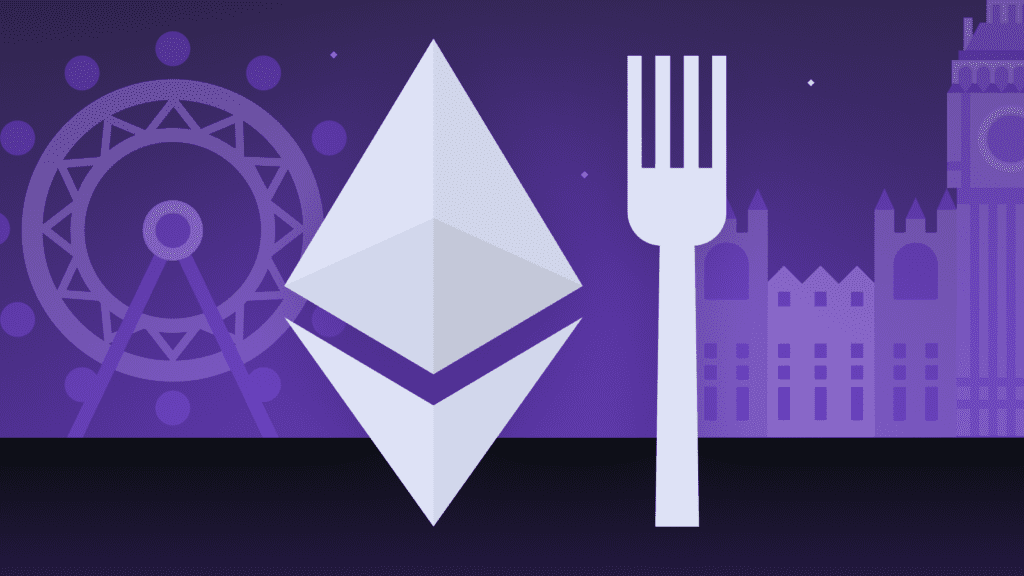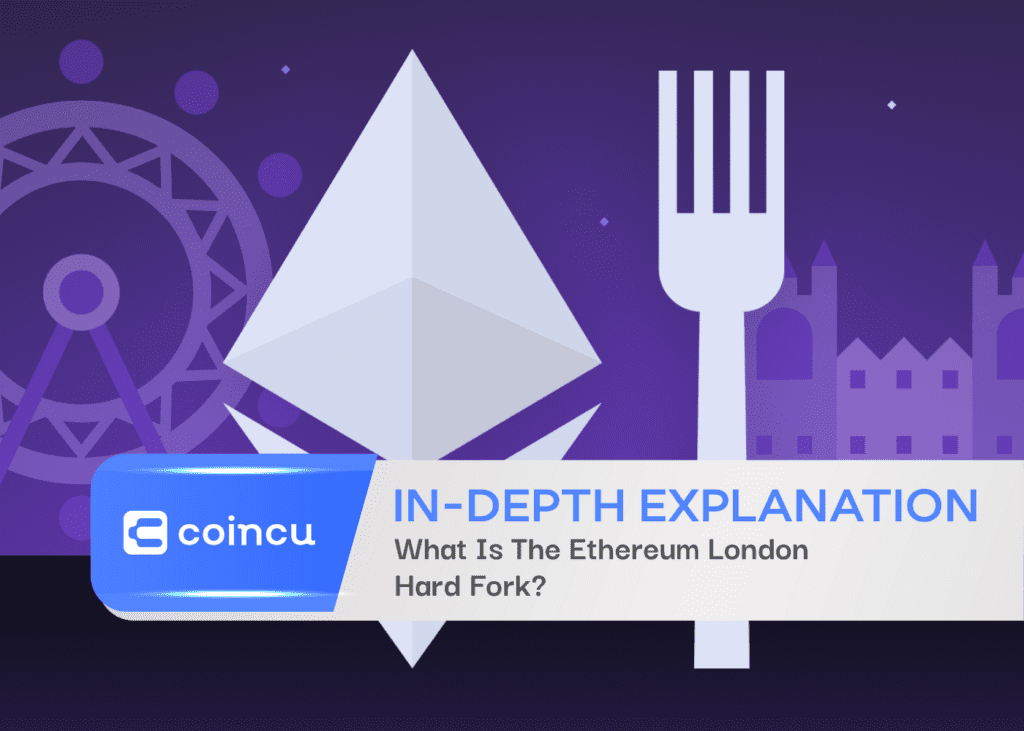Ethereum London Hard Fork – Blockchain technology is undoubtedly disrupting how the present financial system functions. However, this change won’t happen overnight; instead, it will happen gradually.

Since the first blockchain (Bitcoin) birth in 2009, we have seen fresh advancements and breakthroughs in this technology, making it more useful and compatible with everyday life.
Similarly, the Ethereum London Hard Fork is among the most significant alterations to the Ethereum network.
PoW / PoS: What’s the difference?

To understand why the London Hard Fork was created, we first need to understand the difference between proof-of-work (PoW) and proof-of-stake (PoS).
Both are two different consensus methods of cryptographic mining. The concept of consensus/mining is crucial for the decentralized existence of a blockchain. Since there is no central body to check for the legitimacy of transactions before they are validated, it is done with the help of mining.
Different users (miners) try solving highly complex algorithms in the proof-of-work mechanism. When this algorithm is solved successfully, a new block is added to the blockchain.
The first miner to solve it is rewarded with some tokens as an incentive. This method relies on massive computing power, consuming a lot of electricity.
In the case of the proof-of-stake, no one is required to solve any algorithmic problem. Instead, the PoS mechanism involves staking your crypto tokens. Different holders (staker) of a specific cryptocurrency temporarily lock (stake) their tokens to validate new blocks on the blockchain.
The system itself does all the work and approves transactions. Users who staked their funds are rewarded with more tokens when a new block is added successfully.
What are Hard Forks?
A hard fork is a backward-incompatible upgrade in a cryptocurrency network. Backward-incompatible upgrade means a software update (or a set of software updates) incompatible with the existing blockchain protocol.
So, the blockchain network ends up splitting into two different networks. Changes made due to a hard fork are permanent, unlike soft forks that are backward-compatible. There have been several Ethereum hard forks in the past, such as Ethereum Classic, EtherZero, and Metropolis.
The London Hard Fork Ethereum Improvement Proposals
London Hard Fork introduced five new Ethereum Improvement Proposals (EIPs). It went live on August 5, 2021. The purpose was to make some preparations before the release of Ethereum 2.0 (Serenity) and shift to the PoS protocol.
Miners have seen a continuously increasing difficulty in mining on the Ethereum blockchain. This upgrade encouraged all the active nodes on the blockchain to use the latest version of the Ethereum Client to continue mining.
These EIPs are described on the official Ethereum website as follows:
- EIP-1559: improves the transaction fee market
- EIP-3541: prevents deploying contracts starting with 0xEF
- EIP-3554: delays the Ice Age until December 2021
- EIP-3529: reduces the gas refunds for EVM
- EIP-3198: returns the base fee from a block
Complex? Don’t worry. Just read the following few sections. We explain these EIPs in the simplest possible way.
What is an Ethereum Improvement Proposal?
With no centralized entity to make decisions, everything on a decentralized blockchain, such as Ethereum, has to be approved by the community before implementation. Things on the Ethereum blockchain are done with the help of an Ethereum Improvement Proposal (EIP).
Usually, developers present these proposals along with suggestions from the community. However, anyone can present an EIP and submit it for discussion. An EIP has to go through several steps involving peer reviews and drafts before being approved by the community.
The guidelines for all EIPs to ever come were outlined at the time of EIP1:
“The EIP should provide a concise technical specification of the feature and a rationale for the feature. The EIP author is responsible for building consensus within the community and documenting dissenting opinions.”
EIP-1559
EIP-1599 is a fee market upgrade. Let’s explore this.
Ethereum is in the process of becoming deflationary. It is because Ethereum, unlike Bitcoin, has no fixed supply, cap-only an annual limited supply of 18M ETH.
Only 21 million Bitcoin tokens will ever exist, but Ethereum has no limit on how many tokens can be mined. Miners are rewarded with new tokens each time they add a new block, which is almost every 15 seconds.
The value of an asset is determined by its scarcity. And something created in abundance has no scarcity in the eyes of a long-term investor.
That is exactly why we see so many fiat currencies lose value as governments keep printing more money. The same concerns have been raised regarding Ethereum’s value over the long run, as it also has no fixed supply.
EIP-1559 attempts to tackle this problem. Since its implementation, the transaction fee will no longer go to miners. Instead, all tokens paid by users for any transaction on the Ethereum blockchain go straight to the network, and then they are burned. It can result in the current total supply of ETH reducing over time and boosting its price.
EIP-1559 also deals with another critical issue regarding Ethereum’s gas fee. Before, there was no fixed transaction fee for users on Ethereum, either. Users used to bid against each other to complete their transactions before others.
As the DeFi sector bloomed and NFTs became a hot trend, the Ethereum ecosystem became congested. As a result, gas fees increased significantly.
This reached the point where the average transaction fee was too costly for small transactions. For example, paying a $25 transaction fee to transfer ETH worth $25 is not sustainable.
EIP-1559 proposed a new pricing model for the transactions. A base fee will be created for each block. The fee will increase if the block is filled more than 50% with transactions.
Users can still offer miners a tip to complete their transactions before others. But Ethereum’s attempt to keep the block full to just the 50% mark reduces this need, as so much space will be available in each block.
EIP-3554
Another important EIP implemented is EIP-3554.
Ethereum has a feature developed into its blockchain, making mining harder over time. It increases the time it takes to mine a new block into the network and reduces the incentive reward. It is commonly referred to as a “difficulty time bomb.”
The purpose of the difficulty time bomb was to make sure that all the miners had no choice but to stop mining Ethereum 1.0 due to the decreasing profitability and shift to the Ethereum 2.0 network. It would avoid the split in the mining community, as we witnessed earlier between Ethereum and Ethereum Classic.
However, without EIP-3554, the Ethereum blockchain would have reached this point too soon, causing several complications. EIP-3554 pushed the difficulty time bomb back to December 2021, allowing miners a little wider window to shift from the old network to the new one.
EIP-3554 cleared the way for the next big step in developing this ecosystem, i.e., “the merge.” Making all the miners shift to the newer PoS network makes it easier to merge Ethereum 1.0 with Ethereum 2.0. At this point, the merging procedure should be completed.
Reactions of the Ethereum Community
The hard fork was big news and ignited various reactions to the changes implemented, mainly regarding the transaction (gas) fees. Many miners were unhappy as the EIPs reduced their rewards for completing a new block.
The gas fee was already a lot less (2 ETH) than it used to be (5 ETH) some years ago. And establishing a base fee for each block will reduce it even more.
People are also concerned that shifting the network to a PoS consensus mechanism will make ETH mining centralized. Only the miners with the largest funds staked and lowest energy cost will be able to drive profits, seems to be the fear.
Final thoughts
Owners of ETH were reassured by representatives of the Ethereum development team that their current method of interacting with the blockchain would remain unchanged. No cryptocurrency exchanges or Ethereum wallets will be impacted by the London Hard Fork (web and hardware).
Everyone now involved in the Ethereum ecosystem is interested in lower gas fees and faster transaction times, which should significantly enhance adoption in the future.
DISCLAIMER: The Information on this website is provided as general market commentary and does not constitute investment advice. We encourage you to do your research before investing.
Join us to keep track of news: https://linktr.ee/coincu
Website: coincu.com
Annie
Coincu News





